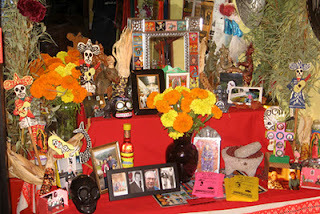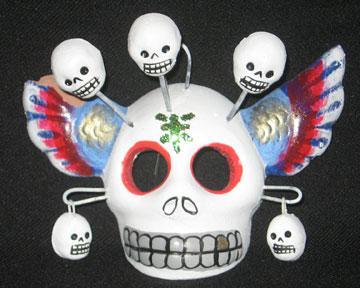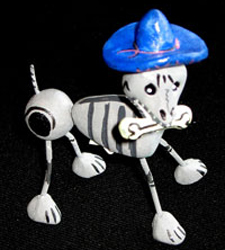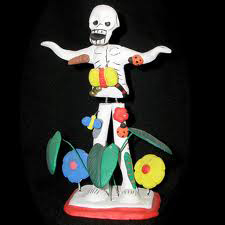El Dia de los Muertos, or Day of the Dead, is a national holiday in Mexico. Its origins are found deep in the ancient ceremonies of indigenous Mexicans. It is traditionally celebrated on November 1 and 2.
Death has a unique persona in Mexico that is not found anywhere else in the world. In pre-Hispanic culture, death was just a further step in life itself. A step that offered a security and serenity markedly contrasting that of the suffering and worries which afflict mankind in this world of hardships. Life and death complement each other. The ancient Mexicans believed that life issued from death just as death issued from life.
With the introduction of Catholicism, attention was no longer focused on Death itself, but rather on the dead and on the spirits. And so the Mexican people celebrate every November 2 on the return of their dear departed who, as ethereal souls, come back for one day to their burial place and the home where they lived.
In many homes a ritual altar is prepared to honor the returning souls. In Mexico, altars are often adorned with Zempasuchitl, a kind of marigold which is the traditional flower of the dead. In some arrangements gladiolus and lilies are used as well.
Day of the Dead is getting a lot more attention in the United States, not just because of the Hispanic population, but because it has a certain authenticity and quirkiness that appeals to people across all spectrums. In Europe, the Day of the Dead is a huge celebration with white flowers being used in celebrations and on alters. White mums, white lilies and white roses being used extensively. In the United States, orange and yellow lilies, as well as marigolds, gerbera and sunflowers are used for bouquets, altars and as gifts.
There is also incense and a candle to light the way for each returning soul on the altar. Food is prepared, always the dish of which the dead was fondest of in life. A glass of water is set out with personal mementos and an image of the person.
For children, delightful toys, usually skeletons made of paper mache and wire are created for the Day of the Dead. These calaveras, or skulls, and dancing skeletons are wonderfully amusing. All walks of life and occupations are depicted. There are even toy cardboard coffins from which a skeleton can be made to jump by pulling a string.
Today in Mexico, Day of the Dead is a custom that is rapidly changing. Although celebrated traditionally in rural Mexico, in the urban centers the Halloween influence of the United States is evident. It is important to remember that Dia de los Muertos is not Halloween, for its origin and rituals are different. It is from the ancient indigenous beliefs which held that Death defines life and that our deaths illuminate our lives.
The altar (ofrenda, where "offerings" are placed) is central to observing the Day of the Dead and is maintained to ensure good relations between the family on earth and family in the after world. Whatever the deceased enjoyed in life is remembered in preparing the alter. Often a calaca is placed on the ofrenda representing what the person did, or enjoyed in life. Photographs occupy the center, and names are spelled out with cloves on fruits and with pen on nuts. Religious images are placed on the alter in the hope that the saints thus venerated, will intercede for the protection of the soul on its' journey back to the after world. Decorations may also include a Tree of Death, tombstones, lyres, flowers, skulls and skeletons of all sizes and materials, copal and delicately formed hearts.
Altars can be an eight-course, multi-level feat with enough "soul foods" set out to provide the sustenance required for the visiting soul. These include dishes traditionally prepared for the Day of the Dead, such as chicken in red or black mole sauce sprinkled with sesame seeds; fruit, beans, tortillas and tamales made from fresh hand-ground corn; soft drinks; and as always, a glass of water to refresh the travel-wearied souls. Altars honoring children include a small bowl of milk, special cakes called mamones, copal (incense), pieces of chocolate, little apples, miniature candlesticks and a profusion of toys and sweetmeats.
Once the honored guest has extracted the essence of the refreshments, the food is shared with family and friends who have often traveled long distances to take part in the family's annual reunion.
I would like to extend a very special thank you to Los Bagels, a multicultural cafe located in Arcata, California. The above information about Dia de los Muertos is used with their permission. Please check out their website, www.losbagels.com



